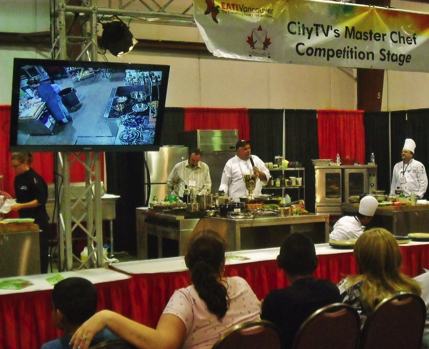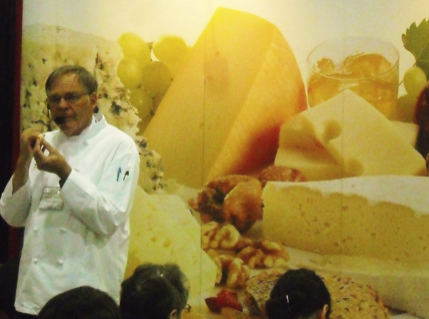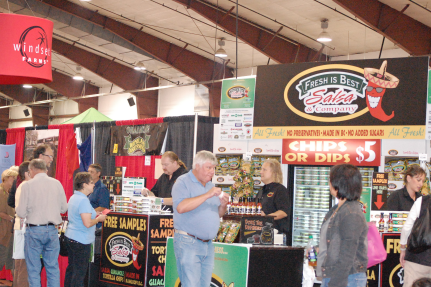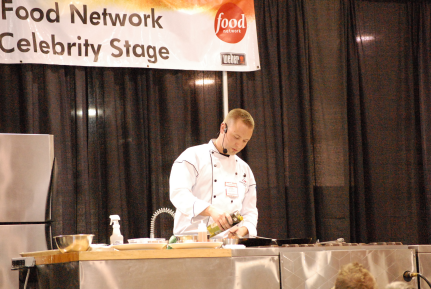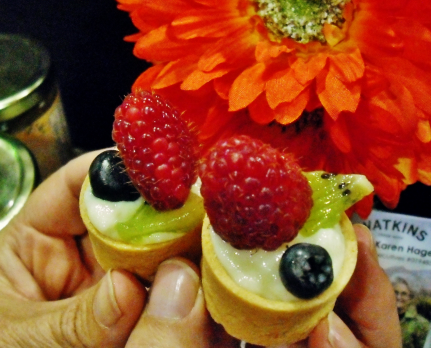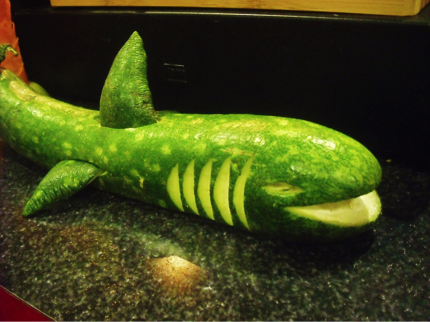
By Amy Van Veen and Sasha Moedt – Email
Date Posted: September 29, 2011
Print Edition: September 28, 2011
Master Chef Competition Finals
Though the master chef competition is a prestigious event, with winnings valued over $2000, the atmosphere was generally friendly. Of course, there was the odd jab at one another as the finals took place. Nevada Cope, champion of last year’s competition in Vancouver, did her best to defend her title from up and coming Kamloops chef, Romeo Olorejismo.
The competition was “black box” style, which basically means the chef must devise a main course by only using the foods the black box contains, which are ingredients unknown to the participants prior to the competition. The chefs had to improvise, relying on creative talents to come up with an innovative idea and prepare it in the time allowed, which was thirty-five minutes.
Competitors were also allowed to take one ingredient from their stores prior to knowing their ingredients. Nevada Cope used green apple sauce in her main dish for an interesting twist. She was the first female winner of the master chef competition last year, beating sixteen other males. This year, however, old Romeo took the prize.
The Cheese Seminar
Did you know there are hundreds – possibly a thousand – different varieties of cheeses? And did you know that they are not grouped or classified by a single method? It’s the final frontier. But, it is hard to classify cheeses; there are the vague “types,” the hard, soft, firm, and fresh. Then take into consideration all the elements of making it: the ageing, ripening, controlling the moisture content, texture and fat-milk content. No wonder it’s tough to classify, and so interesting to learn about.
Luckily then, The Dairy Farmers of Canada had their own seminar area. I heard a loud voice from afar: “If it’s a heady, strong, goat’s milk cheese, why would you pair it with a dark, full-bodied fruit wine?!” My head snapped in that direction. It sounded important.
I stood in line, hoping to get a seat for the next seminar. The people sitting in the lecture already had cheese samples sitting in front of them, listening to details on wine and cheese pairing. I learned that cheeses and wines, beers and ciders, are essentially good partners based upon the balance of salt and sweet they provide. You have to consider acidities, aroma, and textures, though. Creamy with tannic can’t go wrong, and rich and smooth with bubbles goes well. With my limited experience in wines (though I can’t say the same for cheeses), I hung on every word.
The lecturer was Reg Hendrickson, a trainer and consultant with Dairy Farmers of Canada. He guided the attendees through a “sensing” of the varieties of cheese at each seminar, also touching on the subject of the storage techniques and production of cheeses and how that leads to the texture.
A woman in front of me, Casey, had the same idea as me: “I thought the cheese samples looked really good so I’d better stand in line!”
The atmosphere, Casey said, was “really lively.” At that moment the cheese consultant lifted a pale chunk of cheese to his nose and inhaled exaggeratedly. The audience followed suit. Lively it was; people can be very passionate about food. “Can you smell that pungent odour?” Hendrickson asked the crowd.
Casey watched, and then continued, “Everyone at the stands are really nice and happy to talk about their restaurant and their food,” she said, and then pointed to the master chef competition: “Even the competition is really easygoing, nice and interesting to watch even though I think the final is on right now…it’s worth an afternoon I think.”
“You really get the feel of Abbotsford and the people in the Valley here, so that’s really nice to see…” She trailed off, and then stared hard at me, making it clear that she was aware of my antics. I had tried to budge by interviewing her, because she stood near the front of the line.
Unfortunately, I had to return to my spot, which means I didn’t get in, but I did learn that those “all you need is cheese” commercials weren’t lying.
The Clayburn Village Bed and Breakfast stand
Leslie Stettler sat in front of a blown up photo of a lovely Victorian-era room, looking to talk to the public about her and her husband’s establishment, the Clayburn Village Bed and Breakfast. As a very new B&B, two months open, she was hoping for some exposure.“We think the kind of people who are interested in fine food would also be interested in fine accommodations which are uniquely different than a hotel offering. Hopefully people will remember us!”
Their booth was quite crowded, according to Leslie. “We were overwhelmed at times… you could barely get down the aisles. Lots of people [have] stopped to talk at our booth after we handed out tea bags wrapped in a small envelope which said ‘To Die For’ on the outside. Those are advertising our Murder Mystery Nights.”
The Murder Mystery night, she explained, is an overnight game for those Sherlock Holmes buffs out there. “We set some weekends aside in October and November for couples or groups to come to our event,” she continued, “they get wine and appetizers, a three course meal, the Murder Mystery game, overnight in one of our luxury rooms and breakfast the next morning!”
Basically, guests are given the roles of suspect, murderer, sleuth, and so on. Their murders are from the 1900s and on. As a guest, you would be assigned a character and info about that character, too. Clues are revealed throughout the night, over dinner and dessert.
“We found all of the folks [here are] very friendly. The vendors [could] spend lots of time talking about the items they’re promoting… overall it was all very positive. The response is great!”
The Cranberry Booth
Most of the booths were decorated in interesting ways to attract the attention the people passing by. One of the most interesting booths was the BC Cranberry Marketing Commission. The cranberry lady was standing in her waders and galoshes, knee deep in a pool of floating cranberries.
When I asked her if she was uncomfortable standing all day in water, she handed me a yogurt-covered cranberry. “Well, you have to wear padding for standing on the cement floor, but it’s waterproof. The main thing is, for us, when we stand in a pool of beaten cranberries in our gear you get a lot of attention.”
The cranberry booth was set up not so much for food (though the yogurt cranberry was pretty good, and so was the dried cranberry I got later) but for education about what the cranberry harvest is all about in the Fraser Valley. “We talk about what the industry in BC is like so people understand about cranberry farming and how significant it is for the province.”
Ninety five per cent of BC’s cranberries are grown for the processing market, like the yogurt covered berry, while the rest are sold as fresh berries. Cranberries are actually BC’s largest berry crop, quantity and value-wise.
I got a lesson as to how cranberries are harvested. They grow on low-lying vines, in a bog removed of its wild growth. When it’s harvesting time, the field is flooded and “beaten” so that the cranberries, which grow in clumps, float on the surface. They are then corralled by booms, and pumped and loaded onto trucks.
“We’re busy and it’s fun. It’s a lot of fun to do, and we get a lot of really good feedback. So we’re pleased to be here and share our cranberry farming stories. It works for us really well.”
Chef Derek Bothwell of Chill Winston
Chef Derek Bothwell of two downtown eateries shared his own take on the classic calamari appetizer at the Celebrity Chef Food Stage on Friday, September 16. Although Bothwell is also the brain behind the food at Guilt & Co., it is his position at Chill Winston that occupied most of the conversation.
Chill Winston is located in Gastown and its food philosophy is cooking from scratch in an ethical manner. It boasts a huge patio and hip atmosphere for people who want a place to eat and relax. They’re open 11 a.m. to 1 a.m. every day and they adhere to a “no reservations” policy.
Bothwell likes to work with the seasons when it comes to creating his menus. In the summer he leans his sauces towards more of a yogurt base, but in the winter he brings romesco onto his plates for that hearty, savoury taste that seems to pair so easily with cold weather.
The romesco is what Bothwell pairs with his calamari. Most every red sauce out there is tomato based, but for this chef heartburn is a nagging issue and the acidity of the tomato doesn’t work well. His solution? He makes his romesco with a red pepper base so that he can still take advantage of those wonderful fall vegetables, without having to pair his meals with Zantac.
Calamari, he admits, can be an intimidating dish for a novice foodie, but squid need not strike fear into the hearts of many. You can buy squid mantle from any fishmonger and one place where it’s guaranteed to be found is Steveston. If, however, you don’t feel like driving down Highway 99 for some mantle, you can pick it up frozen at a local grocery store (just remember not to buy it in tentacle form – the meat is in the mantle). The key to making the little calamari curls is to score the top of the piece so that when it fries, the fish can form into those delightful little curls, so after cutting it open, use a sharp knife to scrape out the guts and start the scoring process.
Bothwell likes, as I mentioned, to serve his calamari in red romesco sauce, but every good chef knows that even the best sauces need a bit of an oomph. He seems to favour olives, and handpicks them for his restaurant. Interestingly, the greener an olive is, the less ripe it is, so it depends on what flavour is desired for the dish.
The fun part is what comes next: every aspiring chef would like to create a really good frying pan fireball, but not every chef is so confident in their own skills to be able to do this without (a) acquiring severe burns on their hand or (b) losing one or both eyebrows. Bothwell has the perfect solution for such a problem. Get a skillet quite hot to the point when the oil in the pan is smoking, once the pan is at that temperature, all you have to do is drop the cut, scraped and scored mantle into the oil and let the fire speak for itself. It’s just a flash in a pan, literally, but that’s half the fun. It only takes about 45 seconds to cook the calamari, and once it’s done you can scoop it out onto a paper-towel lined plate. At this point, a regular skillet is going to have some build-up which is when it’s time to reach for the pinot gris to loosen it up, then add olives, garlic, chorizo and other ingredients to the romesco, fry up some mushrooms and shallots, add the romesco mixture to the pan and then add the calamari to the sauce. Top it all off with some fat (butter or cream) and let the flavours get to know each other before serving it out on a plate. From start to finish, this meal only takes about 15 minutes.
When asked what his favourite meal would be, if he was forced to choose, Bothwell went classic with another twist. He favours a strip loin bison steak with mushrooms and bone marrow mixed with butter on top. The bone marrow gets at the core of the beefy flavour, enhancing the entire plate’s delicious factor.
Organic Eating?
It’s not news to anyone that ethical eating is quickly becoming the main concern of conscientious eaters, but it’s not always easy to be sure the food at the grocery store adheres to one’s own social conscience.
Black Creek Ranch, based out of Kamloops, offers everyone’s solution to the Food, Inc. dilemma in the form of grass-fed beef. They promise to be “no antibiotics, no hormones, all natural.” When asked if they were certified organic, they explained that being “certified organic” doesn’t necessarily mean that you are prohibited from using antibiotics. Even certified organic farms still occasionally use antibiotics in the treatment of their animals. Black Creek Ranch, though, includes their promise in their slogan for a reason. They do not deliver to many locations in the Valley, but they do offer it at Choices in Vancouver; according to their website, they “combine deliveries with pick-ups by working with Heartland Quality Foods” in order to lessen their carbon footprint.
The Chicken Out! booth had a rather interesting eye-catcher of chickens in a cage. According to the lady there, she had seen more than several people double-take her booth out of fear that they were live. It was a great conversation starter in learning about what eggs the ethically minded grocery shopper should buy. If a product promises “free run” eggs, that does not mean the same as “free range.” For a chicken to be “free range,” the chicken has to be outside a third of their lifetime, but “free run” eggs just means they are loose in a barn with no outdoor outings to speak of. When asked about what the Black Creek Ranch booth said about certified organic sellers still using antibiotics, she explained the process of treating an ill bird. If a farm is certified organic, they must remove the ill chicken and treat it separately from the rest and only when it is completely healed can they return it back to the flock. Ultimately, though, there is no better option for egg buying than certified organic which is guaranteed to be free range.
Along this vein of ethical farming is one place that’s rather close to home: located on Sumas Way across from Winners and only five minutes east of UFV, Vitala Foods offers shopping with a “low carbon footprint, sustainable farming practices and animal comfort and care.” Even though they cannot actually receive organic certification because, according to their website, “organic certification standards do not currently exist for ocean-based fish stocks,” they adhere to the same rigid principles of local, natural foods. Their yogurt, which they had out as samples, is naturally sweetened with only the sugar from the real fruit and real fruit juices used. I sampled the blackberry and was tempted to take the whole tray with me. Their eggs, though, are what struck me as the most interesting. They are currently in the process of coming out with new eggs that have more vitamin D. Instead of fortifying the eggs, the vitamin D will be given to the chicken and the egg the chicken lays will then have a greater vitamin D content making the process much more natural. Vitala food products can be purchased at local grocery stores such as Safeway, or straight from their location on Sumas Way.
For those who want to keep up with the next greatest eco-friendly, ethically driven, sustainable farming product, it can be difficult to keep track of where to shop, where not to shop, and which farmer’s markets are open when. However, My Garden Footprint offers the solution to this particular conundrum. Their goal, like many others, is local, sustainable shopping and they facilitate this in two ways: they work with local businesses, schools, restaurants and old folks’ homes to ensure this practice is followed from Langley to Chilliwack and they also have a website that has a list of local farmers for every product you can think of, as well as recipes, gardening tips and a community forum.

